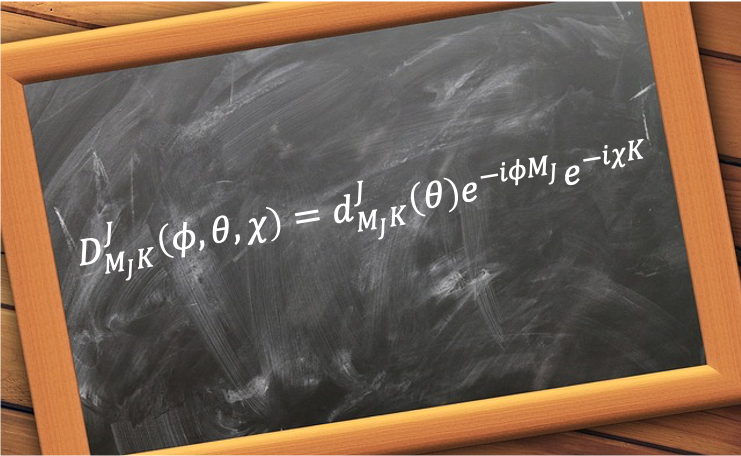The Wigner D-matrix , where the total angular momentum
is a unitary matrix that represents all rotation symmetry operations corresponding to the irreducible representations of the SU(2) group.

The irreducible representations of SU(2), or special unitary group of degree 2, consists of unitary matrices with determinant 1. They describe angular momentum transformation for particles with both integer and half-integer values of
. In the case where
is an integer, the corresponding Wigner D-matrices also represent the irreducible representations of the SO(3) group, which is the group of all proper rotations in 3D space.
As shown in the previous article, the total rotation operator transforms a quantum state
with total angular momentum projection along the molecular
-axis into a linear combination of states
with the projection along the lab
-axis:
Since forms a complete orthogonal basis set for SO(3), the coefficients of
, according to group theory, are the matrix elements of
. Multiplying the above equation on the left by the bra
gives the Wigner D-matrix elements:
Substituting eq115 into eq120 yields:
where is an eigenstate of
by convention.
If , then
(see this article for proof). So,
and eq121 becomes:
Since and
is Hermitian, i.e.
, we have
. It follows that
where is the Wigner small-d matrix element.
The corresponding Wigner small-d matrix is a single-axis, single-angle rotation operator of the SO(3) group in the
basis.

Question
Why is expressed as a matrix element without explicitly carrying out the operation
?
Answer
is an eigenstate of
, but not of
. This can be shown by combining the angular momentum raising and lower operators (
and
) to give
. Substituting eq144 and eq147 into
yields:
with expressed in
units.
Since mixes the
states when acting on
, the state
is not an eigenstate of
. Therefore,
is conveniently expressed as a matrix element, rather than by explicitly carrying out the exponential operation, which would involve a linear combination of multiple
states.
, other than being matrix elements of Wigner D-matrices, are also rotational wavefunctions. To explain why, we refer to the great orthogonality theorem for finite groups, given by:
where
The theorem can be extended to infinite groups like SO(3), with the normalised sum over group elements replaced by a normalised integral over all rotation angles :
where
-
, the total volume of the SO(3) manifold (intrinsic rotation space), is the normalisation factor for the integral, i.e.
.
(see this article for further explanation).
is a specific set of
values.
Eq124 reveals that the functions are complex and orthonormal. They are eigenfunctions of
and
(in
units), where:
and
Since there are infinite SO(3) irreducible representations, are associated with all possible combinations of the three rotational quantum numbers and hence all possible eigenvalues. In other words,
form a complete orthonormal set of wavefunctions for symmetric rotors.